Home » Jazz Articles » Live Review » Ultra Music at Pori Jazz Festival: Pori, Finland, July 14-16, 2011
Ultra Music at Pori Jazz Festival: Pori, Finland, July 14-16, 2011

Pori, Finland
July 14-16, 2011
The port of Pori has always been a hub of access for Finns living in the flatlands of the west coast area. As a center for the export of wood and cereals, the city traditionally has seen the import of ideas and styles from the visiting seamen. And for the last 46 years it has witnessed the influx of foreign musicians in mid-July, participants in the country's oldest summer jazz festival. The Scando-European town, with its post-modernist concrete architecture and post-industrial former factories, fills for the duration of nine days with vacationing Finns and local residents eager to make the most of the light summer nights and the associated party spirits, not forgetting the music.
This year's two biggest stars, Elton John and Tom Jones, obviously do not play jazz but have the power to pull in the customers. This enables the program to include the selection of non-commercial acts which make up the established (14 years) but newly styled uLTRA mUSIC nIGHTS. The venue has relocated from the rough-hewn floors of the old cotton factory warehouse to the secondary stage of the grand Pori Theater, right in the center of town. And again, in moving with the times it has succeeded in improving this year's attendances dramatically despite the fact, suggested by the title's font, that this is music at the margins of the norm.
Chapter Index
Night One: uLTRA dANCE mUSIC
Along with the program's current and original producer Charles Gil, the flavor of the first night was indefatigably French, as appropriate for July 14. In previous years this primarily Franco-Finnish program had never fallen so early in the month, and now the opportunity to celebrate the Gallic holiday was not to be missed. Eight French men and one French woman filled the stage, along with such an array of instruments that it was clear from the outset that a riotous evening was in store. With every musician in the Tous Dehors group fielding a minimum of three instruments, not to mention the two non-Gallic guests' contributions, the regal main stage of the theater was set for a show to rival Frank Zappa's appearances with a full symphony orchestra.
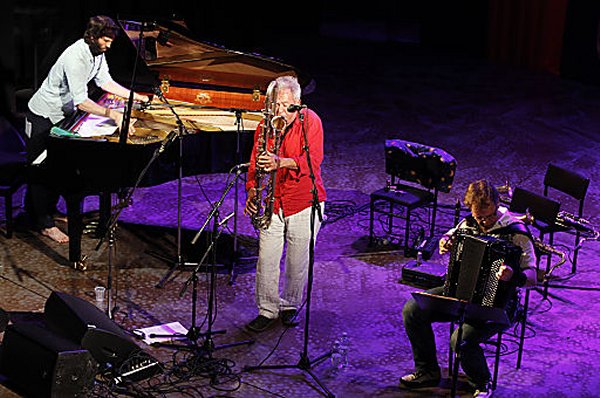 From left: Matthew Bourne, Laurent Dehors, Veli Kujala
From left: Matthew Bourne, Laurent Dehors, Veli Kujala The music of the Alain Dehors group was equally scintillating, witty and whacky, with the difference that all these 'Frenchmen' were both technically and temperamentally soloists. Many pieces involved the full weight of two electric guitarists, four reedists, a tuba and vibes along with a large drummer and his large kit; but many pieces also featured room for extensive individual or small group interaction. This offered some relief to the onslaught of sound, energy, contrapuntal rhythms (at one point hand-clapped front of stage by the reedists) and frenetic ideas that had originated in the mind of Mr. Dehors. As he explained to the audience, "these are the sounds of my dreams which we try to play for you." He is not a light sleeper!
In contrast to the hubris of the first part of the evening, the second portion of the show entitled "Love Songs" was more calm and reflective, involving only Dehors with his principal guitarist David Chevalier, joined later by the same guests, pianist Matthew Bourne and accordionist Trio Chaud with Veli Kujala in Helsinki Finland. With a back-catalog of experience as a solo artist, street performer, as well as an orchestral player, the leader again reveled in the opportunity for flamboyance while working with a more meditative canvas than earlier. The pieces here were shorter and more concise, more Albert Ayler than Ornette Coleman.
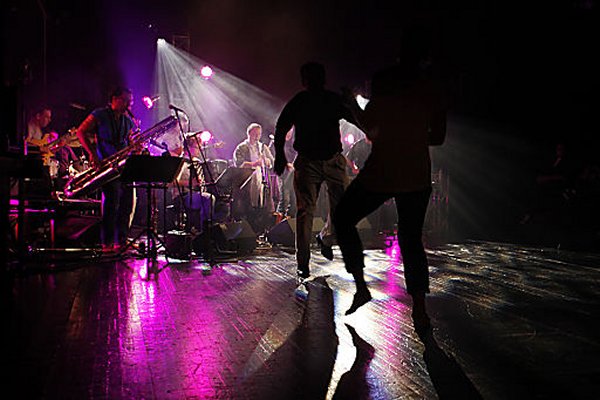 The Tous Dehors band performing for the dancers at the post-concert uLTRA dANCE event
The Tous Dehors band performing for the dancers at the post-concert uLTRA dANCE event The final leg of the evening was an unapologetic celebration of French fun, in the form of a jam/dance session with the band offering more accessible music for the early morning party-minded crowd. Squeezed along a wall of the theater's smaller side stage, Dehors' troupe whipped up extended medleys of French chanson, jazz and pop which had the French ambassador up and jiving along with the rest of the punters. Powered by the mighty, double-brass bass section (tuba and bass saxophone in tandem) the evening rocked into the early hours with bundles of entente cordiale.
Night Two: uLTRA cHAMBRE mUSIC
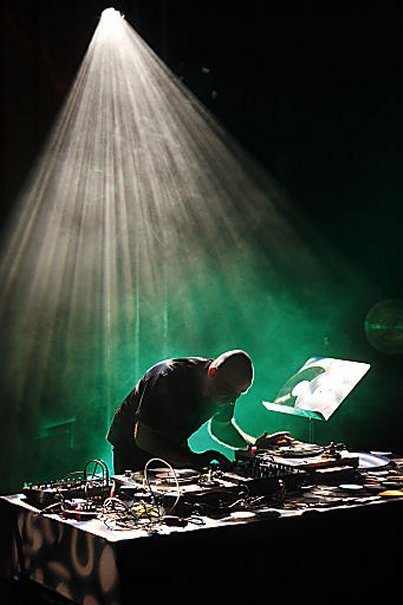 The second night of ultra jazz was a selection of three acts under the title "Chamber Adventures," and although the first act comprising Matthew Bourne and Franck Vigroux was a duo playing an extensively electric set, the music of all artists was of an intensity to fall easily under this rubric. Both men are recognized as instrumentalists, Bourne on the piano and Vigroux on the guitar, but only the piano featured in this performance, and even this was overshadowed by the power of the electronic mix of Vigroux's live sampling from his turntable and Bourne's performance on his veteran Moog synthesizer. Two years previously in Pori, Bourne had used pre-recorded samples of speech to structure his flow-of-consciousness style of improvisation, creating a single piece that lasted over 40 minutes. At the time his piano was in turn impenetrably dense or melodic. Now with live sourcing of speech, melody or pure noise, he split his interpretation between short sessions at both the acoustic piano and Rhodes, and longer workouts on his synthesizer. As a result, the performance was harder to digest as a whole and even harder to comprehend. However, this show was not primarily for cerebral appreciation, but a further exploration of the boundaries between music and noise, structure and chaos.
The second night of ultra jazz was a selection of three acts under the title "Chamber Adventures," and although the first act comprising Matthew Bourne and Franck Vigroux was a duo playing an extensively electric set, the music of all artists was of an intensity to fall easily under this rubric. Both men are recognized as instrumentalists, Bourne on the piano and Vigroux on the guitar, but only the piano featured in this performance, and even this was overshadowed by the power of the electronic mix of Vigroux's live sampling from his turntable and Bourne's performance on his veteran Moog synthesizer. Two years previously in Pori, Bourne had used pre-recorded samples of speech to structure his flow-of-consciousness style of improvisation, creating a single piece that lasted over 40 minutes. At the time his piano was in turn impenetrably dense or melodic. Now with live sourcing of speech, melody or pure noise, he split his interpretation between short sessions at both the acoustic piano and Rhodes, and longer workouts on his synthesizer. As a result, the performance was harder to digest as a whole and even harder to comprehend. However, this show was not primarily for cerebral appreciation, but a further exploration of the boundaries between music and noise, structure and chaos. The bar for the evening having been not so much set as shattered, the second performance re-established the classical meaning of chamber music, at least as defined by sixteenth century English composer John Dowland. His piece "Flow My Tears" was referenced in a jazz context by the interpretations of baroque violinist Maya Homburger, drummer Janne Tuomi and their principle composer and bassist Barry Guy. Guy's piece entitled "Dacrymon" was described as a type of exorcism of his earlier work with Dowland's music, including production of the disc In Darkness Let Me Dwell (ECM, 1999).
As in the first part of the program, the music demanded exquisite coordination between the musicians, which in turn put more pressure on established Finnish percussionist Tuomi to integrate with the long established partnership of Hombuger and Guy. The synthesis of the two stringed instruments with Tuomi's percussion was effective, and the Finn added plenty of color from his ample range of gongs, cymbals and plates, in addition to the full kit with its two bass drums!
The principal impetus for the music was the prepared 5-string bass that Guy uses in live performance, bowing, plucking or caressing with a variety of objects, creating an intensity of the same level as produced by the quantities of sound from Bourne and Vigroux, here with the addition of a whole variety of sonic subtlety. One special highlight was the final sequence of seven sketches entitled "Tales of Enchantment," inspired by the New York painter Elana Guttman, where the trio combined in various alignments to offer a range of timbre and sonority, sometimes frenzied, but always serene.
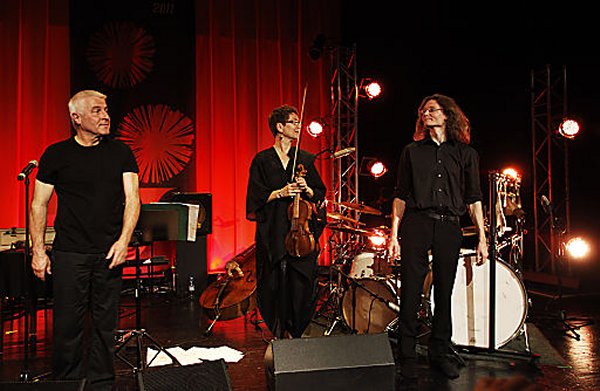 From left: Barry Guy, Maya Homburger, Janne Tuomi
From left: Barry Guy, Maya Homburger, Janne TuomiThe final performance involved a multi-national group of four young musicians called The New Songs, powered by two female musicians, both with great grace and subtlety. Eve Risser has been playing prepared piano in many line-ups, most recently in Finland with Japanese drummer Yuko Oshima in Donkey Monkey. In this program much of the composition was shared, and the vocals were from the supremely competent cords of Ethiopian-Swedish singer Sofia Jernberg, playing with guitarists Kim Mhyr from Norway and David Stackenäs from Sweden.
The strong acoustic quality was maintained with both guitarists shunning any amplification beyond a local microphone, filling the mid-range with variety achieved through different finger-styles, variation in tunings on a selection of instruments (including a 10-stringed lute/bouzouki), and different preparations. Jernberg's voice was as clear and controlled as the harmonics of the two guitarists, and despite a set of only five songs, she set out her range of color with panache. The effect was delicate but deliberate, as on her measured interpretation of a poem by former South African freedom fighter, now minister, Mongane Wally Serote. The combination of four perceptive young musicians carefully harmonizing with each others' musicality brought the evening to a sublime close, with the promise of record release later this year.
Night Three: uLTRA eLECTRONIC mUSIC
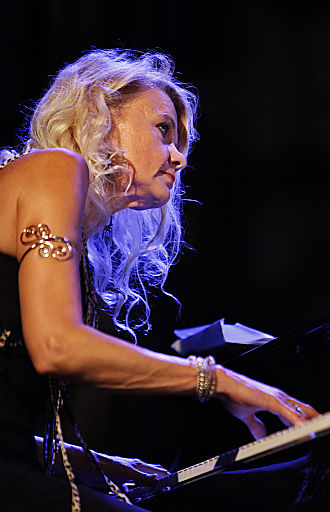 The final evening of this series of European experimental music once again featured an amalgam of Finnish and foreign musicians, all experimentalists in their art. First up and playing as iXt was the team of Iro Haarla on piano, Tapani Rinne on clarinet, and Tuomas Norvio manipulating the electronics. They produced a sometimes sparse, sometimes dismembered, always abstract and always intense program. Haarla and Rinne have worked extensively since their first association in Edvard Vesala's ensemble Sound and Fury in the late 1980s. Both have worked with an array of other musicians, but only once as part of a trio. Both have developed over time to become more meditative in their work, in contrast to many artists during the previous two evenings, leaving plenty of space for each others' moods and for audience involvement.
The final evening of this series of European experimental music once again featured an amalgam of Finnish and foreign musicians, all experimentalists in their art. First up and playing as iXt was the team of Iro Haarla on piano, Tapani Rinne on clarinet, and Tuomas Norvio manipulating the electronics. They produced a sometimes sparse, sometimes dismembered, always abstract and always intense program. Haarla and Rinne have worked extensively since their first association in Edvard Vesala's ensemble Sound and Fury in the late 1980s. Both have worked with an array of other musicians, but only once as part of a trio. Both have developed over time to become more meditative in their work, in contrast to many artists during the previous two evenings, leaving plenty of space for each others' moods and for audience involvement. Hence also the role of the live mixer as a key link between these moods. Norvio has long been part of Rinneradio's line-up, working under his alter ego's name Verneri Lumi. Initially inspired by the work of Richie Hawtin, Norvio's role in subtly adding to the original acoustic sound of both instrumentalists creates a whole dimension of meaning and value to the poise and feeling of their music. In particular the middle range of timbres and rhythms were expanded by Norvio's contribution, adding continuity and reinforcing the unity of the show.
The second act continued to highlight the pivotal role of the mixer in cutting edge free-jazz, this time with two established names from the world of Finnish electronica. Led by producer, DJ and arranger Pekka Tuppurainen, the very Scandinavian RöD/BLå also featured the all-analog effects of house mixer Jori Hulkkonern. The sextet in Pori built upon the success of the recent release of the eponymous double album (Aeon, 2010) with a single 50-minute improvisation based loosely on the compositions on the album, starting from David Bowie's "Abdulmajid," followed by a short piece written by the pianist Aki Rissanen. These three individuals form something of a cerebral focus within the band, evident when they started the encore in a highly restrained manner before being railroaded by the later entrance of the three acoustic musicians in unison, and at full volume.
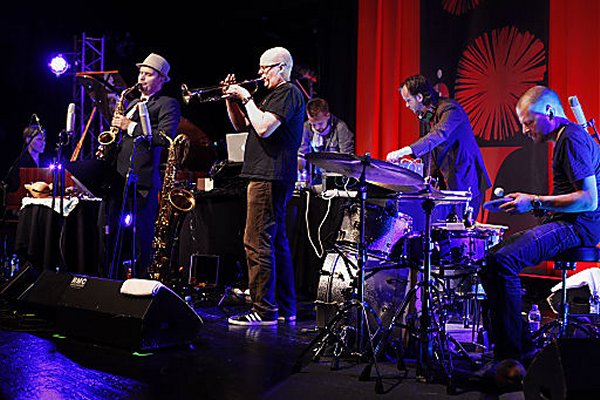 Finnish sextet RöD/BLå, featuring Swedish trumpeter Magnus Broo
Finnish sextet RöD/BLå, featuring Swedish trumpeter Magnus BrooThe always innovative saxophonist Mikko Innanen and fellow member of the Helsinki nu-jazz circles drummer Joonas Riippa joined Swedish trumpeter Magnus Broo center-stage in the major work, leading the band through the changes either on tenor or baritone saxophone or one of the extensive collection of acoustic sound sources from his traveling suitcase. Innanen and Riippa seem equally eager to extend their palette beyond their primary instruments, having spent recent years straining just to push the boundaries of sound and solipsism as far as they can. Their experimentalism works best in just such a large band where one or more of the other players can pick up on and develop their musical quips, be they squawks and shrieks from a hand-held car horn, or blips and blops from a wobbled plastic saxophone mute. Although Tupparainen is nominally in charge, the interpretation could and did stray well off the rails at times, but at no time lost its sense of humor, nor the sense of purpose. Finding the appropriate phrase to end on was challenging, but was successfully resolved!
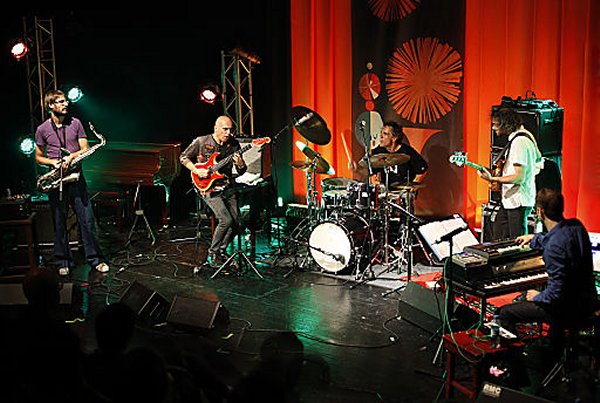 French keyboardist Paul Brousseau's Kolkhöze Printanium, featuring guest guitarist Marc Ducret
French keyboardist Paul Brousseau's Kolkhöze Printanium, featuring guest guitarist Marc DucretThe evening's final line-up was exclusively French, a quintet of instrumentalists under the direction of keyboardist Paul Brousseau, called KoLKHöZe PriNTaNiuM (KKP). Composing under the influence of early rock and electronica, keyboardist Brousseau was intent to "explore the innards of rock music in order to compose music that's influenced by the 60's acid rock," while still remaining open to the influence of modernists, like those of his visiting guitarist of the evening Marc Ducret. While Mayot Hugues on tenor sax retains a style that is faithful to the original concept of acoustic jazz, the overall sound and style of KKP is closer to a dedicatedly experimental instrumental electric group like the Norwegians Shining or Motorpsycho.
Critical to the sound and current style is bassist Jean-Philippe Morel, who determinedly drives the bottom end with deft but relentless lines, processed beyond any normal bass palette, and matched in its intensity by Phippe Gleizes' drumming. Sitting on the cusp of the genre with their original guitarist Maxime Delpierre, or in the final ultra hours at Pori with Ducret, Brousseau's spacey keyboards and KKP's power took the final session of the series to an extreme of modern improvisational music, well beyond the orbit of any conventional jazz gathering, but happily encompassed still by the Pori mainstream.
Photo Credit
All Photos: Maarit Kytöharju
< Previous
A Fresh Take
Comments
Tags
Pori Jazz Festival
Live Reviews
Anthony Shaw
Elton John
Tom Jones
Frank Zappa
Veli Kujala
Albert Ayler
Ornette Coleman
Janne Tuomi
barry guy
Eve Risser
Iro Haarla
Mikko Innanen
Magnus Broo
Marc Ducret
Shining
Motorpsycho
For the Love of Jazz
 All About Jazz has been a pillar of jazz since 1995, championing it as an art form and, more importantly, supporting the musicians who create it. Our enduring commitment has made "AAJ" one of the most culturally important websites of its kind, read by hundreds of thousands of fans, musicians and industry figures every month.
All About Jazz has been a pillar of jazz since 1995, championing it as an art form and, more importantly, supporting the musicians who create it. Our enduring commitment has made "AAJ" one of the most culturally important websites of its kind, read by hundreds of thousands of fans, musicians and industry figures every month.






















